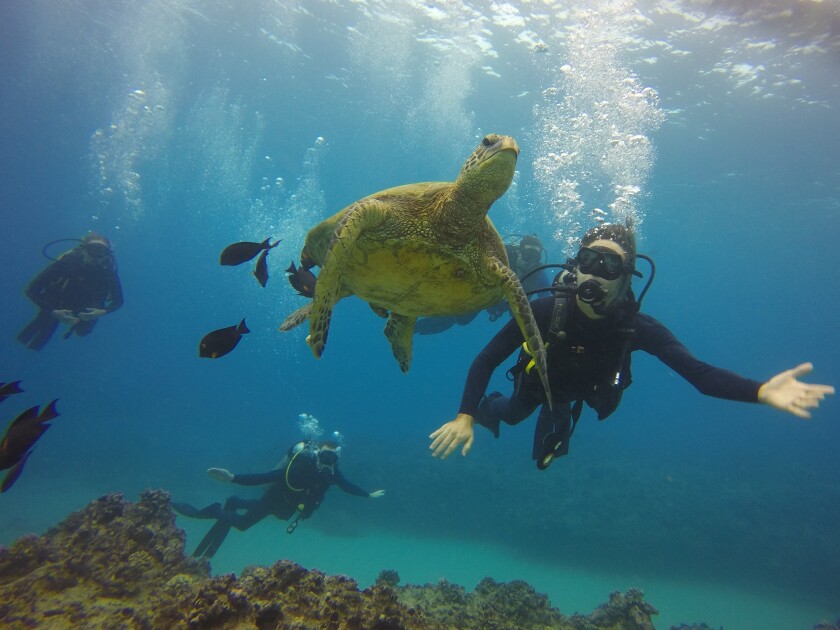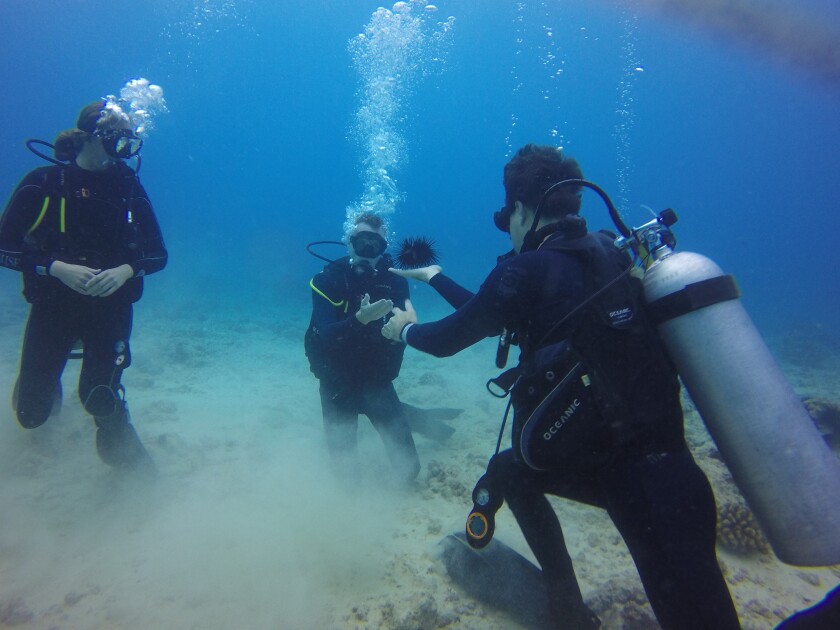
Curt Christiansen, the advisor of the BYU–Hawaii Dive Club for the last 16 years, said his first encounter with diving occurred when he was 15 years old. Now, after more than 30 years of diving experience, he looks back on his underwater adventures and said the best part about diving is experiencing it alongside someone else.
Where it all began
Christiansen said when he was a 15-year-old Boy Scout he went to Camp Lemhi in Idaho where he saw a man setting up his scuba gear on the boat dock of a small lake.
He shared, “I was waiting to start my canoeing merit badge, and I was watching him put his gear together. Then I saw him turn on the tank and I asked him about it.” Christiansen said the stranger told him he was checking to make sure all of his gear worked and invited him to try it out.
Christiansen said, “We got in shallow water and he turned on his scuba tank.” He said the scuba tank has two mouthpieces: the backup, which is the one he used, and the regulator, which the other guy used.
“I was underwater and holding to the side of the boat dock. Looking around, I could see fish underwater. I could see things I couldn’t normally see when I was up kayaking or swimming,” he said.
The experience was one he would remember and that day Christiansen said he told himself he would do it someday for real.
In 1988, Christiansen said he moved to Hawaii as a student and became scuba dive certified on Oahu. He said he first had to learn to be comfortable with the water. Activities like snorkeling and spearfishing helped him gain an understanding of the ocean, he added.

The world underwater
While describing what it’s like to scuba dive, Christiansen said, “Sometimes you’re underwater and you forget you are underwater. You look up and you see the surface of the water … and it reminds you. I’m in this environment. I’m clear down here underwater. I don’t worry about breathing because it’s all set up. I don’t have to have any fear or panic to get to the surface because everything is okay down here.”
It’s cool to look up and see the surface of the water, he said. “It’s almost like a ceiling above you, and you’re separated from the world of air,” said Christiansen. “ You’re enclosed in a world of water and there’s a whole different world down there.”
Christiansen said diving is like living in an altered reality where animals are breathing on their own underwater and you are there experiencing it with them. “You’re down there doing something that isn’t normal to be doing without equipment. … It’s better than going to the movies.”
Before the pandemic, Christiansen said he would scuba dive half a dozen times a year. One of the places he loves to go to is Lanai Lookout, an advanced dive not for beginners, he said.
“Scuba diving on the island is just like surfing. It’s seasonal,” Christiansen said. In the winter there are big waves on the North Shore, so people go to the south shore or the west side to dive, he explained.
During the summer it would be the opposite, he added.
“You can scuba dive all year round as long as you are willing to go where it’s calm … because the waves change to each side of the island every six months,” he said.

The BYUH Dive Club
Christiansen said he became the advisor of the Dive Club at BYUH about 16 years ago. “In the Dive Club, we get people certified to Open Water Diver, the basic level, and then they can go on and become an Advanced Scuba Diver or become a Dive Master, the highest rank before instructor.” He has been a Dive Master for about 30 years, he said.
“A basic diver should have their own mask, fins, snorkel [and] booties,” he shared. Scuba gear consists of a Buoyancy Control Device (BCD), which is the vest, a tank, a weight belt, a regulator and a suit, he said. “A part of the [club] fee to go scuba diving is a rental of [this] equipment,” he explained.
Diving teaches people how to take care of the environment and how much of what people do affects it, he said.
“Sometimes when we’re out diving, we see some trash like a plastic bag or some fishing gear that’s left out there, and we pick it up so the next diver doesn’t have to see that and it doesn’t tangle up sea creatures in it.”
Divers should take care of the environment so everyone can enjoy it more, he said.
Brandon Moore, a senior from Alaska majoring in art education and Dive Club vice president of activities, said the fee to be part of the club this semester is $3. If a student wants to get certified it will cost them $350 because they have to pay the dive guide, he shared.
“Unlike a driver’s license where you have to renew it every couple of years, once you get certified, you’re certified for the rest of your life,” Moore explained.

Moore said it took him a couple of weeks to get his diving certification. “What you do is you [spend] a couple of nights in a classroom where you watch a bunch of videos about diving. [Then] you have a workbook that you’re supposed to read and answer questions in, and then you’ll meet with the instructor in a classroom [where] he’ll go over all the questions in the book,” he shared.
After that, Moore said, divers do their first dive in a swimming pool, followed by four more dives in the ocean. “It’s really pretty quick. It’s not a process that takes months,” Moore said.
“It’s a pricier club and that is one of the things we always caution people about. … But as far as the benefit, diving is just one of the coolest ways to explore the ocean,” he added. If the dive is from a boat it’s $100, and if it is a dive from the shore, where divers just walk into the water, it’s $50, he said.
“You can spend 10 minutes looking [at] a little five-by-five area of coral and find all sorts of fish, animals [and] crabs. It’s so much fun. It’s an amazing way to experience the ocean that you really can’t experience in any other way,” Moore commented.
A social sport
When asked what the best thing about diving is, Christiansen said it is the interactions with fellow divers. “It’s a buddy system, so you’re usually paired up with somebody else for safety,” he said. Each pair watches each other while diving, occasionally inspecting each other’s air and communicating underwater through signals, he explained.
“You then get to experience things underwater together. … You often point at things underwater so your buddy can see it also, so they don’t miss [what you discovered].”
When the divers get out of the water, everyone is excited to talk about what they saw and it is really fun, he added.
“As much as it is a recreational sport, it’s a social sport,” Christiansen said. Diving together makes it really fun, he said.
Christiansen’s wife, Dr. AnnaMarie Christiansen, an associate professor in the Faculty of Arts & Letters, said, “We see the ocean, but we often do not look at what is underneath. [Diving is] a great way to explore nature in an underwater context.”
She echoed her husband when she said, “It’s a social activity that is fun to do with your partner and with the group that you know well. It’s fun to become certified [by taking] the classes through the Dive Club with someone you’re dating or some of your friends and work [through] that process together,” she shared.

When the two got engaged, AnnaMarie Christiansen said her husband automatically signed her up for scuba diving lessons. She said her husband loves to get people interested in diving. Both of their daughters are certified through the BYUH program, she shared.
On one occasion, while they were both scuba diving, AnnaMarie Christiansen said a little tiger shark swam by. She said she was afraid but her husband stepped in front of her to protect her.
“He is very conscientious, and safety is very important to him,” she added.
Moore said Curt Christiansen is one of the most experienced divers he knows. “If you have any questions about diving, Curt has something to say about it, which is really cool.” Moore said he enjoys talking to Christiansen about his diving experiences. He can go on forever talking about it, he shared.
Besides being the adviser to the Dive Club, Curt Christiansen works for BYUH Facilities Management as the capital assets and key access coordinator.
